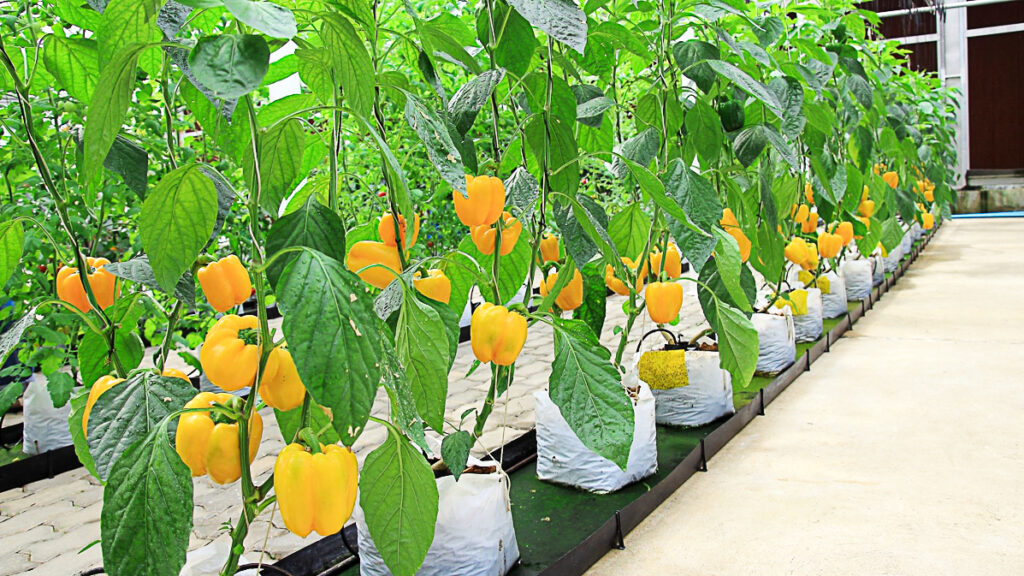Growing hydroponic peppers is a popular option for chili lovers. It is also an excellent option for growers who don’t have enough space or prefer to grow pepper indoors. Let’s learn how to grow peppers hydroponically.
*This post contains compensated links. Find more info in my DISCLAIMER. As an Amazon Associate, I earn from qualifying purchases.
Want to start a hydroponic garden at home easily? Check out our recommendations for Best Hydroponics Starter Kits for Beginners.
Growing Hydroponic Peppers At Home
In hydroponic growing, plants are grown directly in water instead of soil. A lot of people believe that all plants require soil to grow. In reality, the soil is only a reservoir for nutrients.
You can also grow Kratky peppers by simply suspending your pepper over nutrient-rich water.
In hydroponics, a hydroponic fertilizer is used. The hydroponic fertilizer is mixed with water. Crops are then planted directly into the water from which they absorb the nutrient.
Hydroponic chili growing has excellent benefits because the growth rate of pepper plants increases. Mixing pepper nutrients with water makes it easier for the plants to absorb the nutrients. Hydroponics answers the question of how to make peppers grow faster.
Hydroponic peppers do not need soil to grow, making it easy to grow pepper. However, peppers need a medium to offer physical support. Among the best medium for growing hydroponic pepper is Rockwool and gravel.
Benefits Of Growing Hydroponic Peppers
There are several benefits of growing pepper hydroponically which include:
- It is easier because there is no problem dealing with weeds
- You do not need to worry about the plants getting infected with soil-borne diseases
- You can grow more plants per square foot than in conventional growing
- Best use of nutrients and moisture hence more efficient than the traditional method
- You can grow hydroponic peppers any time of the year.

Best Pepper Varieties For Hydroponics
There are different pepper varieties. However, some of the best types of hydroponic peppers are Ace Peppers, California Wonder, Vidi, and Yolo Wonder.
See some of our favorite kits for growing vegetables and herbs at home:
The Best Vertical Garden Kits And Planters For Home
The Best Tomato Growing Kits For Home Gardeners
The Best Hydroponic Peppers Systems For Growing At Home
Growing kits are a good option, especially for beginners. Growing kits come with everything you will need to grow hydroponic peppers. Most kits include an instruction book that makes your work easy.
QYO 12 Pods Hydroponics Growing System

This hydroponic kit will yield 20 to 25 percent more than planting in ordinary soil. The plant will also grow 20 percent faster.
QYO kit has a pump that automatically turns on and off every 30 minutes. The pump continuously supplies water, oxygen, and nutrients to the plants.
This growing system will allow you to grow your hydroponic peppers anywhere, anytime. It has a full-spectrum smart light that automatically stays on for 16 hours and turns off for 8 hours.
Environet Hydroponic Pepper Growing Kit

This growing kit contains one net pot, a grow plug, and a mason jar. The kit requires low maintenance since it is self-watering. A wick pulls water from the jar to the plant’s roots, ensuring that the plant takes in as much water as needed.
This hydroponic pepper kit is also a beautiful home décor. You can place it on the kitchen counter or a window sill.
Growing hydroponic pepper is one way to increase your yield and reduce your time before harvesting your pepper. The method is also less messy since there is no soil involved.
Growing Hydroponic Peppers Indoors Vs. Outdoors
Another great benefit of hydroponic peppers is that you can either grow them indoors or outdoors. Growing them indoors will give you more control over the growing conditions.
If you are growing your hydroponic peppers indoors, ensure that the plants get enough light. You can use LED grow light to provide additional lighting. Pepper requires a lot of light to grow. Ensure that the plants get 14 to 18 hours of light a day.
Pepper seeds will germinate in 7 to 14 days. The plants will take approximately 50 to 80 days to mature fully. During the germination stage, ensure that the temperature is around 78 to 80 degrees Fahrenheit.
Best Systems For Hydroponic Peppers
There are several hydroponic growing techniques that you can use to grow pepper. The following are among the best systems.
Static Solution Hydroponics
In this system, you fill containers with a static nutrient solution and grow pepper in them. Aerate the solution using air pumps so that the roots get the oxygen they need to grow.
Change the solution at least weekly to maintain the best nutrient concentration.
Continuous Flow Hydroponics
This system is best for larger setups involving a lot of plants. You pump water continuously around the plants’ roots. The system has automated nutrient level adjustments.
Nutrient Film Technique
The nutrient film technique is one of the most common techniques for growing hydroponic peppers. You plant roots in sealed narrow gullies where a shallow film of nutrient solution flows.
This system allows the roots to nutrients from the solution. The system is the most efficient. However, the plants are at risk of starvation and death if the nutrient flow is not enough.
Our 5 Top Tips For Growing Hydroponic Peppers
Tip 1 Choose A Suitable Variety
When it comes to hydroponic peppers, you should carefully choose the type of pepper to grow.
Some pepper varieties need a lot of space to grow because they grow into large plants. Other types spread their roots extensively. Wisely choose when deciding the type to grow hydroponically.
Tip 2 Choose A Suitable Hydroponic System
The space available, the equipment required, and the cost are some of the factors to put in mind when deciding on your hydroponic system. The variety of pepper you choose to grow will also determine the method you settle for.
Tip 3 Pick Seeds And Saplings From Healthy Pepper Plants
One way to ensure that you succeed in growing hydroponic peppers is by choosing the correct seeds and saplings. You can germinate seeds or use cuttings and transfer them into the hydroponics system. Either way, use seedlings and cuttings from healthy plants.
Tip 4 Ideal Conditions
Temperature and light play a crucial role in the growth of your hydroponic peppers. Ensure that temperatures are in the range of 73 and 78 degrees Fahrenheit.
Hydroponic peppers should have access to light for 14 to 18 hours a day. If natural light is not sufficient, use LED grow lights.
Tip 5 Choose The Correct Medium
Hydroponic peppers grow directly in water mixed with a nutrient solution. The roots of these plants will therefore require physical support.
Make sure you choose the correct medium to support the roots. Rockwool and gravel are among the best medium. However, ensure that you sterilize the medium to prevent infection.
FAQs – Hydroponic Peppers
Yes. Nearly every variety of pepper including bell and chili can be grown hydroponically. Best of all, peppers grow very well regardless of the type of hydroponic system.
With the proper growing conditions, peppers typically take between 7-9 weeks to grow. If you are looking to grow peppers hydroponically, it’s recommended to start with pepper saplings versus seeds. This cuts down on the overall growing time.
